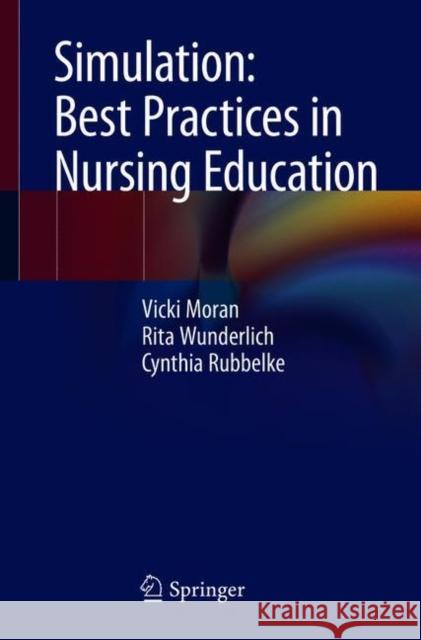Simulation: Best Practices in Nursing Education » książka



Simulation: Best Practices in Nursing Education
ISBN-13: 9783319898209 / Angielski / Miękka / 2018 / 54 str.
Simulation: Best Practices in Nursing Education
ISBN-13: 9783319898209 / Angielski / Miękka / 2018 / 54 str.
(netto: 146,00 VAT: 5%)
Najniższa cena z 30 dni: 146,48
ok. 22 dni roboczych
Bez gwarancji dostawy przed świętami
Darmowa dostawa!
These subject areas are approached following a thorough review of the literature and current practices identified from the International Nursing Association for Clinical Simulation and Learning (INACSL), Society for Simulation in Healthcare (SSH), National League for Nursing (NLN) and State Boards of Nursing.
"This is an excellent, comprehensive resource for both novice and seasoned nursing faculty. The topics are grounded in standards and evidence-based guidelines and the generous use of links and checklists allow readers to have up-to-date information at their fingertips. This book is a must have for any nurse educator. Excellent resource!" (Lisa R. Binns-Emerick, Doody's Book Reviews, November, 2018)
Chapter 1: Simulation in Nursing Education
Background
1.1 International Nursing Association for Clinical Simulation and Learning (INACSL)
1.2 Society of Simulation in Healthcare (SSH)
1.3 National League for Nurses (NLN) Simulation Innovation Resource Center (SIRC)
1.4 National Council for State Boards of Nursing (NCSBN) National Nursing Simulation Study
1.5 Evidence in Nursing Simulation
Defining Excellence in simulation
Chapter 2: Standards in Simulation
Introduction
2.1 Curriculum
2.2 Clinical
2.3 National Council of State Boards of Nursing (NCSBN)
2.4 Approval Standards from State Boards of Nursing (SBNs)
2.5 The Essentials of Baccalaureate Education for Professional Nursing Practice
2.6 Accreditation Standards
2.7 Simulation Accreditation
2.8 Faculty Certification
2.9 Faculty Development
2.10 Resource Websites
Excellence in Simulation Standards
Chapter 3: Simulation Environments
Introduction3.1 Types of Simulation Modalities
3.2 Fidelity - Low, Medium, and High
3.3 Maintaining the Simulation Environment
3.4 Standardized Patients
3.5 Self-Efficacy, Confidence, and Competence
Excellence in Simulation Environments
Chapter 4: Developing Simulations
Introduction
4.1 Steps in the Development of Simulations
4.2 Simulation Design
4.3 Clinical Scenario: Script Writing (Storyboard)
4.4 Debriefing
4.5 Evaluation
4.6 Peer Review and Dry RunExcellence in the Development of Nursing Education Simulations
Chapter 5: Implementing Simulations
Introduction
5.1 Setting the stage
5.2 Facilitating the Simulation
5.3 Student Preparation
5.4 Planning for the Unplanned
5.5 Debriefing
5.6 Evaluation
Excellence in Implementation of Simulation
Chapter 6: Putting It All Together
Introduction
6.1 Health Assessment Simulation
6.2 Medical-Surgical Adult Simulation - Hypertension Crisis
6.3 Advanced Medical Surgical Simulation
6.4 Public Health Simulation
Dr. Vicki Moran graduated with degrees from Saint Louis University, BSN in 1994, MSN/MPH in 1997 and PhD in Higher Education Leadership in 2015. She has taught for over 15 years as didactic and clinical faculty in a variety of levels in pre-licensure nursing programs. She is clinically competent in a variety of critical care settings including trauma. Her meshing of clinical and education has developed a research focus on NCLEX-RN success of the pre-licensure student. Her simulation background and experience has contributed to nursing education. She has consulted with a variety of nursing schools to infuse simulation across nursing curriculum.
Dr. Rita Wunderlich began her career as a nurse in the intensive care, followed by becoming a nurse educator. She continued her educational trajectory by completing her PhD in Nursing in 2000. Shortly thereafter, she expanded her academic career into an administrative role. She is currently an associate professor of nursing at Maryville University in St. Louis, teaching at all levels of nursing education including pre-licensure BSN, MSN, and DNP programs. Her simulation background and experience has contributed to nursing education. She has used simulation extensively across the nursing curriculum for the past 15 years using the most current and evidence-based practice. In addition to being a nurse and an educator, Dr. Wunderlich has held multiple grants, provided extensive input to a number of academic committees, and is an established contributor to nursing publications.This book focuses on evidence-based standards for simulation in nursing education. The foundational principle of simulation excellence and its relevance to nursing is defined and infuses throughout the book. It also discusses necessary components for quality simulation from development to implementation. These areas include (but are not limited to): theoretical background, accreditation and approval standards, the simulation environment, developing and implementing simulations, and debriefing. These subject areas are approached following a thorough review of the literature and current practices identified from the International Nursing Association for Clinical Simulation and Learning (INACSL), Society for Simulation in Healthcare (SSH), National League for Nursing (NLN) and State Boards of Nursing. This quick reference title will become the best practice standards for simulation excellence in nursing education.
1997-2025 DolnySlask.com Agencja Internetowa
KrainaKsiazek.PL - Księgarnia Internetowa









